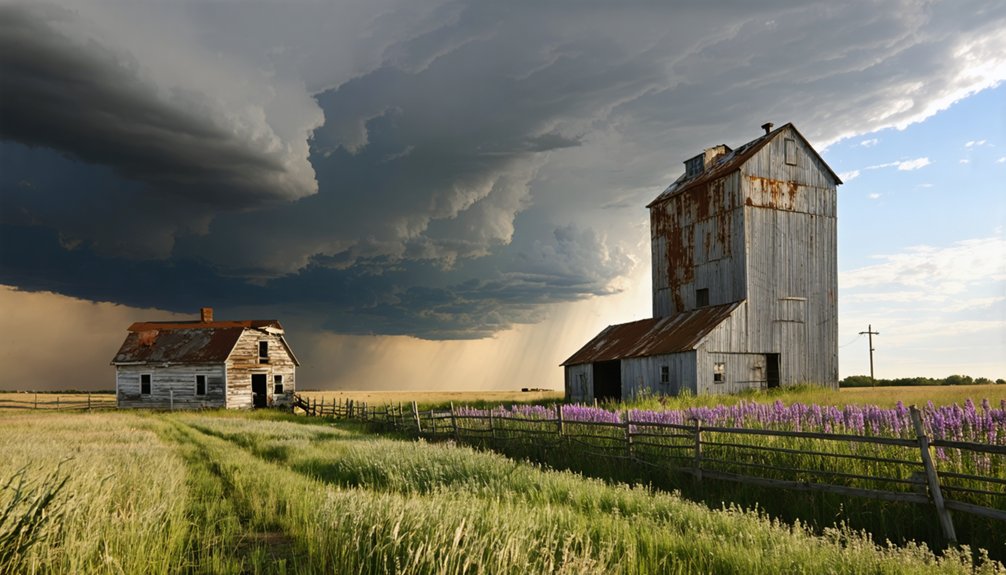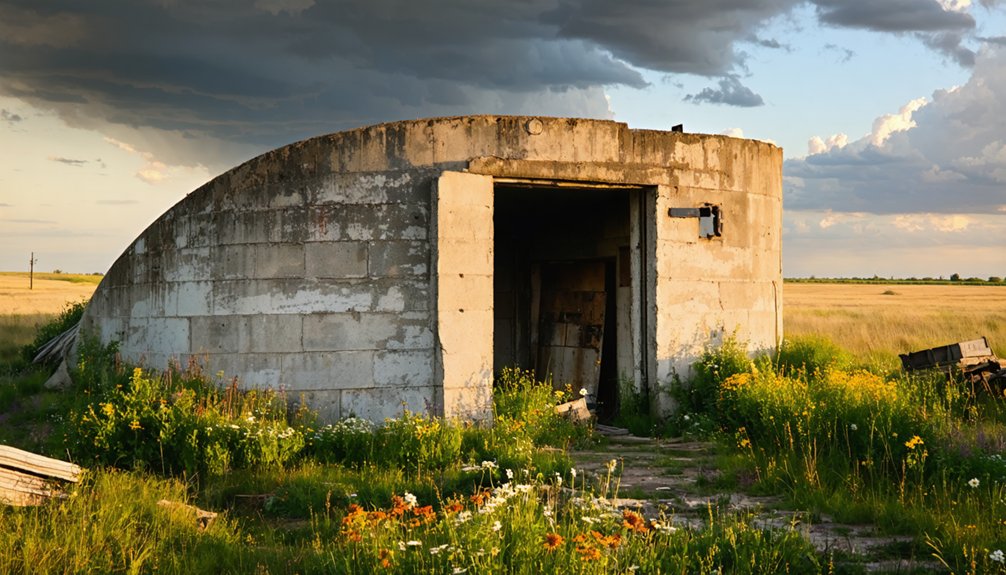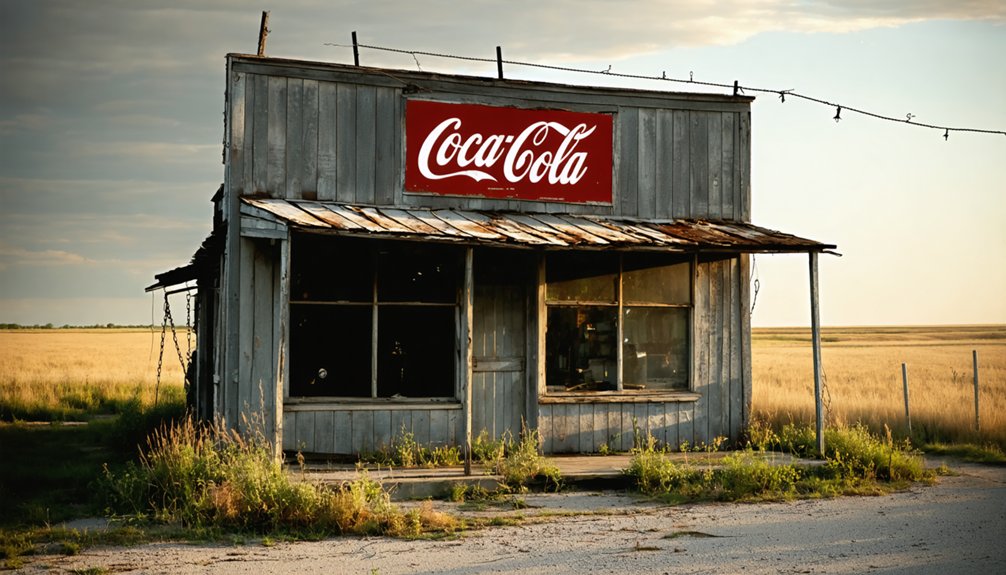You’ll find Igloo, South Dakota as a haunting collection of 800 concrete bunkers and abandoned buildings from the former Black Hills Ordnance Depot, established in 1942. This remote military complex, chosen for its high altitude and low humidity, once housed thousands of workers and Italian POWs while serving as a major WWII munitions hub. After its 1967 closure, the self-contained prairie community emptied, leaving behind a complex legacy of both military significance and environmental concerns.
Key Takeaways
- Igloo, South Dakota was a thriving military community built around the Black Hills Ordnance Depot, established in 1942 near Edgemont.
- The self-contained community featured modern amenities including a hospital, post office, movie theater, and housing for over 750 civilian workers.
- Following the depot’s closure in 1967, the population dramatically declined as workers relocated, turning Igloo into a ghost town.
- Today, over 800 abandoned concrete ammunition bunkers dot the landscape, serving as remnants of the once-bustling military installation.
- The site’s closure devastated the local economy, with hundreds of families leaving and most buildings either demolished or relocated.
The Rise of a Military Town in the Black Hills
When World War II demanded expanded military infrastructure, the U.S. Army strategically established the Black Hills Ordnance Depot (BHOD) in southwestern South Dakota.
You’ll find this 1942 military expansion situated just 10 miles southwest of Edgemont, where the Army capitalized on ideal conditions: high altitude, low humidity, and rolling prairies perfect for ammunition storage. They’d construct over 800 concrete bunkers, dubbed “igloos” for their dome shapes, setting the stage for the town’s future name. Today, these structures have found new life as private survival shelters available for lease to preppers and disaster-conscious citizens. The initial construction phase employed an impressive 6,000 workers by August 1942.
A vibrant community identity emerged as the depot attracted workers from across the region.
You’d see a diverse workforce of local residents, Native Americans, and women staffing the facility, which peaked at 575 employees by 1962. The Chicago, Burlington and Quincy Railroad provided essential supply links, transforming this rural prairie into a bustling military-civilian hub.
Life Inside a Remote Munitions Depot
While living in a remote munitions depot might seem isolating, Igloo’s residents enjoyed a remarkably self-contained community with modern amenities. During peak wartime operations, the workforce swelled to over 750 civilian employees.
You’d find everything from a fully equipped hospital to a post office, and even a movie theater relocated from Wyoming. The community dynamics fostered a uniquely inclusive environment, with Native Americans making up nearly 20% of the workforce. The facility was officially designated as Black Hills Army Depot in the early 1960s.
Your daily life would’ve revolved around both work and leisure. After shifts managing the depot’s 802 concrete bunkers, you could unwind at the swimming pool, bowling alley, or roller rink.
Between managing bunkers and bowling strikes, life at the depot balanced serious work with simple pleasures.
Social activities flourished at the dance hall and recreation center, while regular bus service to Edgemont gave you access to additional services.
Despite the serious nature of handling munitions, you’d experience a vibrant community life that defied the depot’s remote location.
Strategic Significance During World War II
You’ll find Igloo’s remote location in southwestern South Dakota was strategically chosen to protect essential munitions from coastal threats while minimizing civilian risk in case of accidents.
As a major weapons distribution hub during WWII, the facility’s 800 earth-covered storage igloos spanning 33 square miles safeguarded everything from conventional ammunition to chemical weapons. The site also housed Italian POWs during the war years.
The depot’s direct access to the Chicago, Burlington and Quincy Railroad enabled rapid movement of crucial war materiel to support U.S. military operations across the country. The facility supported a thriving community of over 4,200 residents during its peak wartime operations.
Remote Storage Location Benefits
During World War II, the Black Hills Ordnance Depot in Igloo, South Dakota proved to be a strategic masterpiece thanks to its remote location in the southwestern part of the state.
You’ll appreciate how the depot’s positioning maximized storage efficiency through its sprawling layout of over 800 earth-covered bunkers. The area’s low humidity and high altitude created ideal conditions for preserving ammunition, while the rolling hills provided natural protection for enhanced munitions safety.
The Chicago, Burlington and Quincy Railroad’s presence guaranteed smooth logistics, while the remote setting created an essential buffer zone in case of accidents. The facility even housed Italian POW workers during wartime operations.
The depot’s natural camouflage, thanks to grass-covered bunkers blending into the landscape, offered additional security. You’ll find it’s no coincidence that this location served military needs well into the Cold War era.
Weapons Distribution Hub Role
Beyond its natural storage advantages, the Black Hills Ordnance Depot transformed into a powerhouse of wartime logistics that kept America’s military might flowing.
Today, many of these concrete igloos have been converted into what is now known as the Vivos xPoint community, serving an entirely different purpose for modern-day survivalists.
You would’ve witnessed an operation that masterfully overcame logistical challenges by centralizing the inspection, storage, and distribution of thousands of tons of ordnance.
Starting in 1943, the facility also housed Italian POWs who were detained at the depot during wartime operations.
As frontline needs shifted during rapid U.S. military expansion, the depot’s strategic position near rail infrastructure enabled swift weapons movement without urban disruption.
The facility’s massive scale – with over 800 concrete igloos – created unmatched distribution efficiency, preventing bottlenecks at production sites while ensuring continuous supply to forces both domestically and overseas.
This hub became the backbone of America’s wartime munitions network, supporting both Army operations and possibly allied forces throughout multiple theaters of war.
Railroad Access Importance
While many factors contributed to Igloo’s strategic importance, the Chicago, Burlington and Quincy Railroad’s direct spur to the Black Hills Ordnance Depot proved vital in transforming this remote South Dakota location into a significant military asset.
The railroad logistics enabled rapid scaling of operations, overcoming the region’s isolation through efficient munitions transport and workforce movement. The facility’s 33 square mile expanse required extensive rail infrastructure to service its vast storage areas.
You’ll find the rail system was essential in connecting BHOD to nationwide supply networks while maintaining the strategic advantage of an inland location safe from coastal threats.
The spur allowed direct transfer of ammunition to the depot’s 800+ concrete igloos, supported diverse labor forces including Native Americans and Women Ordnance Workers, and facilitated the delivery of essential materials that sustained both military operations and civilian life in this otherwise sparse region.
A Self-Contained Community in the Prairie

As the Black Hills Ordnance Depot took shape in 1942, a unique self-contained community called Igloo emerged on the South Dakota prairie. You’d find a thriving population of over 5,000 residents supported by extensive federal infrastructure, including housing, hospitals, schools, and utilities.
The community dynamics reflected remarkable cultural integration, with Native American and non-Native families living and working side by side. Deep wells provided hot water, while hundreds of concrete “igloo” bunkers stored munitions in temperature-controlled conditions.
Life centered around the depot’s military mission, yet residents experienced an extraordinary sense of solidarity that transcended typical rural town boundaries. Women filled critical wartime roles, and children, including future NBC anchor Tom Brokaw, attended the local Provo High School, making Igloo a complete, self-sufficient prairie community.
The End of an Era: Base Closure and Aftermath
You’ll find the 1967 closure of Black Hills Ordnance Depot struck Edgemont like a heart attack, causing nearly half its population to leave and decimating the once-thriving local businesses.
The military systematically dismantled the base, redistributing assets to other facilities and relocating many housing units to nearby Indian reservations and communities.
While some employees retired locally, many transferred to other military depots across the country, leaving Igloo to dwindle to barely a dozen residents in subsequent decades.
Economic Impact After 1967
When the Black Hills Army Depot closed its doors in 1967, the economic shockwaves reverberated throughout South Dakota’s surrounding communities.
You’ll find that this closure sparked massive economic upheaval, as nearly 700 workers lost their stable income source. The impact hit both tribal and non-tribal residents hard, leading to widespread community decline as families were forced to relocate or face unemployment.
- The Edgemont hospital struggled to survive with the sudden population decrease
- Local businesses that had supported depot workers saw sharp drops in revenue
- Native American workers, comprising 20% of the workforce, lost rare employment opportunities
- Women, who made up almost half the workforce, experienced significant household income losses
The depot’s closure didn’t just affect jobs – it unraveled the entire economic fabric of the region, triggering outmigration and diminishing the local consumer base.
Exodus and Property Liquidation
The announcement of Black Hills Army Depot’s closure in April 1964 set off a three-year exodus that would permanently alter the region’s landscape.
You’d have witnessed a massive community displacement as hundreds of families were forced to relocate, with many transferring to other military installations across America.
The government’s asset redistribution saw Igloo’s houses physically moved to locations like Edgemont and Pine Ridge Reservation, while equipment and furniture found new homes at other bases.
Legacy and Environmental Impact

Nestled among South Dakota’s rolling plains, Igloo’s 21,000-acre military complex has left a complicated environmental and cultural legacy since its closure in 1967.
You’ll find more than 800 earth-covered bunkers scattered across the landscape, slowly returning to nature while holding potential environmental hazards.
The site’s cultural significance lives on through former residents who remember their unique mixed community of Native and non-Native American families.
- Test wells monitored by Army Corps of Engineers reveal ongoing concerns about soil and groundwater contamination
- Stored materials included conventional explosives, mustard gas, and nerve agents like sarin
- Private ownership of fragmented parcels complicates environmental restoration efforts
- Wildlife, including rattlesnakes, has reclaimed portions of the land, indicating partial ecosystem recovery
From Bustling Base to Silent Bunkers
Established in 1942 as the Black Hills Ordnance Depot (BHOD), Igloo’s military complex quickly transformed from barren prairie into a bustling wartime installation.
You’d have found a vibrant community of 4,200 residents by 1945, complete with modern amenities like a hospital, school, theater, and recreation facilities.
Today, this once-thriving military town stands as a haunting ghost town, its abandoned structures telling stories of a bygone era.
Time stands frozen in this deserted military town, where empty buildings whisper tales of its vibrant past.
The site’s most distinctive features – 802 earth-covered concrete bunkers – remain scattered across the hills, silent sentinels of historical preservation.
These “igloos,” designed for munitions storage, witnessed the ebb and flow of military activity until the base’s closure in 1967.
Where Italian POWs once worked and families once thrived, only deteriorating buildings and empty bunkers remain.
Frequently Asked Questions
Are There Any Paranormal Activities Reported at the Abandoned Bunkers?
You won’t find documented ghost sightings or haunted history at these bunkers. While the site’s abandonment creates an eerie atmosphere, there’s no credible evidence of paranormal activity in available reports.
Can Visitors Legally Explore and Photograph the Remaining Structures Today?
You can’t legally explore or photograph these structures without explicit permission, as they’re privately owned with strict exploration guidelines and photography permissions enforced by the current bunker community’s management.
What Happened to the Families Who Were Forced to Relocate?
You’ll find these families scattered across South Dakota, with many settling in Hot Springs and Provo. The relocation impacts split up their tight-knit community, forcing them to rebuild their family histories elsewhere.
Were There Any Major Accidents or Incidents During the Depot’s Operation?
You’ll find several deadly incidents in depot history, including a 1950 explosion killing three workers, a 1946 phosphorus bomb fire, and accident reports detailing a fatal mustard gas bomb detonation.
Do Any Original Structures From the Military Base Still Stand?
While you might expect decay, you’ll still find hundreds of concrete igloo-shaped bunkers and other military architecture standing today, though they’re deteriorating. The historic preservation effort hasn’t prevented nature from reclaiming most structures.
References
- http://www.hervoiceonline.com/news/throughthelens593.html
- https://www.sdpb.org/rural-life-and-history/igloo-south-dakota-the-utopia-that-war-built
- https://indianz.com/News/2012/004212.asp
- https://www.sdnewswatch.org/bunker-community-igloo-south-dakota-vivos
- https://www.coldwartourist.com/black-hills-ordnance-depot
- https://www.onlyinyourstate.com/experiences/south-dakota/abandoned-military-facility-sd
- https://en.wikipedia.org/wiki/Black_Hills_Ordnance_Depot
- https://www.youtube.com/watch?v=p_UJjRk2-g8
- https://www.argusleader.com/story/news/2017/05/30/doomsday-south-dakota-former-military-bunkers-being-used-prepare-apocalypse/354127001/
- http://bhodian.com/briefhist.html



